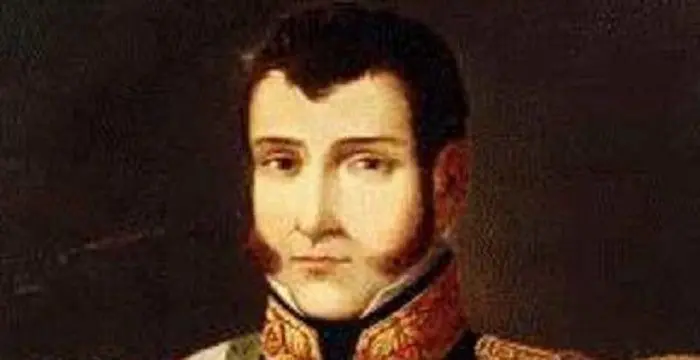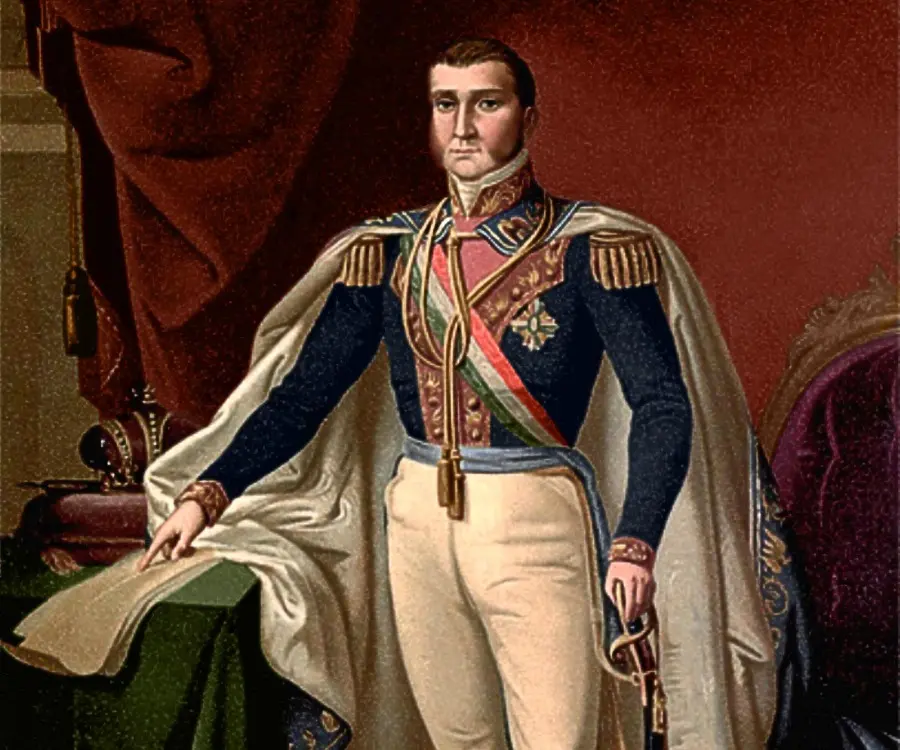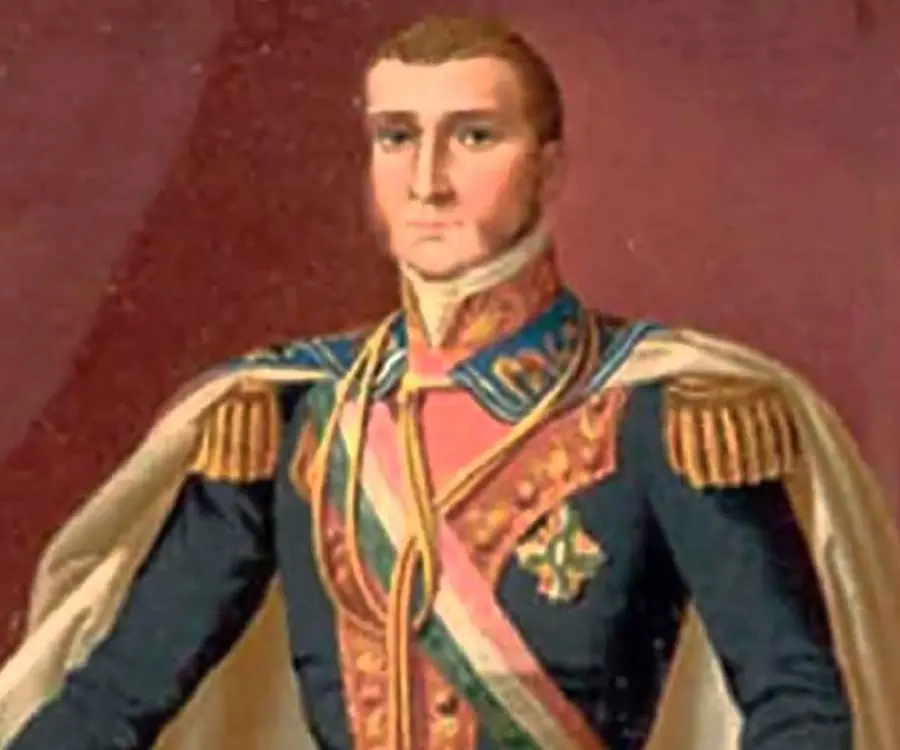
Agustín de Iturbide - Kings, Birthday and Life
Agustín de Iturbide's Personal Details
Agustin de Iturbide was the leader of the conservative faction of the Mexican independence movement who later served as the Emperor of Mexico
| Information | Detail |
|---|---|
| Birthday | September 27, 1783 |
| Died on | July 19, 1824 |
| Nationality | Mexican |
| Famous | Historical Personalities, Emperors & Kings, Military Leaders, Emperor of Mexico, Emperors, Kings |
| Spouses | Ana María de Huarte y Muñiz |
| Known as | Agustin de Iturbide |
| Childrens | Agustín Jerónimo de Iturbide y Huarte, Sabina de Iturbide y Huarte, Salvador de Iturbide y Huarte, Sister Margarita of Jesus |
| Cause of death |
|
| Birth Place | Morelia |
| Religion | Catholicism |
| Gender | Male |
| Sun Sign | Libra |
| Born in | Morelia |
| Famous as | Emperor of Mexico |
| Died at Age | 40 |
// Famous Kings
Sundiata Keita
Sundiata Keita was the founder of the Mali Empire in West Africa. This biography profiles his childhood, early life, struggles, founding of empire, rule, administration, achievements and also gives some fun facts.
Ashoka
Ashoka was the third emperor of the Mauryan Dynasty and ruled almost the entire Indian subcontinent. This biography profiles his childhood, life, reign, achievements and timeline
Murad IV
Murad IV was one of the mighty Sultans in the history of the Ottoman Empire. This biography profiles his childhood, family, accession, rule, administration and timeline.
Agustín de Iturbide's photo
Who is Agustín de Iturbide?
Agustin de Iturbide was a Mexican revolutionist and leader of the conservative faction of the Mexican independence movement who briefly served as the Emperor of Mexico. Iturbide commenced his career as the officer of the royalist army. He remained loyal to the Spanish cause and vowed to serve the same rather than join his cousin, Costilla’s insurgent army. It was his superb defence of Valladolid against the revolutionary forces that led him to take command of the military district of Guanajuato and Michoacán. Iturbide’s most important contribution came in with the Plan de Iguala which was published on February 24, 1821. Through it, he came up with three proposals which guaranteed immediate independence from Spain, equality for Spaniards and Creoles, and the supremacy of Roman Catholicism with a ban on all other religions. In 1822, he was made Emperor of Mexico. However, his supremacy did not last for even a year as he failed to establish peace and stability. Furthermore, opposition from all the parties led to Iturbide’s dethronement and eventual exile. He was later abducted and executed. Despite his failure as the Emperor of Mexico, Iturbide is regarded as one of the great heroes of the Mexican independence movement.
// Famous Emperors
Sundiata Keita
Sundiata Keita was the founder of the Mali Empire in West Africa. This biography profiles his childhood, early life, struggles, founding of empire, rule, administration, achievements and also gives some fun facts.
Ashoka
Ashoka was the third emperor of the Mauryan Dynasty and ruled almost the entire Indian subcontinent. This biography profiles his childhood, life, reign, achievements and timeline
Murad IV
Murad IV was one of the mighty Sultans in the history of the Ottoman Empire. This biography profiles his childhood, family, accession, rule, administration and timeline.
Childhood & Early Life
Agustin I was born as Agustín Cosme Damian de Iturbide y Arámburu on September 27, 1783 in Valladolid, Michoacan, to José Joaquín de Iturbide y Arreguí and María Josefa de Arámburu y Carrillo de Figueroa. He was the fifth and only male heir of the family.
Academically mediocre, Agustin studied at the Catholic seminary, Colegio de San Nicolás in Valladolid. He later enrolled at the program for secular officials.
Career
As he entered teens, Agustin de Iturbide enrolled himself in the royalist army, as a Criollo. After serving as a second lieutenant in the provincial regiment, in 1806, he became full lieutenant.
His fame in army service grew exponentially. His daring attitude, gallant mannerism, peerless horse-riding skills and military prowess gained him recognition as ‘The Iron Dragon’ of the royalist army. He became a feared name for the Insurgents.
During the outbreak of War of Independence in 1810, Miguel Hidalgo y Costilla offered him a post with his revolutionary army, but Iturbide refused and instead vowed to serve for the Spanish cause. He continued his service in the royalist army.
During the war, he fought against the general José María Morelos from 1810 to 1816 in his native city, Valladolid. Due to his tactful approach and horse-riding skills, he successfully defended the city and forced the insurgents to withdraw. His victory earned him the position of a captain.
As a captain, Iturbide chased the rebels, finally pinning down Albino Licéaga y Rayón. His heroic skills earned him yet another promotion as a colonel in 1813. From 1813 to 1815, he became the principal military opponent of Morelos, being chiefly in charge of the military district of Guanajuato and Michoacán. His pursuit ended in 1815 when he successfully captured and executed Morelos.
In 1816, Iturbide faced grave charges against extortion and violence that led to his removal from the royalist forces. He was reproached for being cruel to civilians and for his arbitrariness. Furthermore, he was accused of amassing large commercial holdings, and embezzling military funds.
Iturbide, through the support of his auditor, successfully annulled all charges against him and was reinstated to military command in November 1820, as colonel for the royalist forces.
In 1820s, the Mexican independence movement faced a typical round-about-turn. The conservatives advocated for an immediate independence which led Iturbide to assume a commanding role in the army, allying his reactionary force with Guerrero’s radical insurgents.
Having been convinced that independence for Mexico would guarantee protection against the republican side, Iturbide formed a coalition between the Mexican liberal insurgents, landed nobility and church.
He formed the Plan of Iguala that rested on three major factors: immediate independence from Spain, equality for Spaniards and Creoles, and the supremacy of Roman Catholicism and a ban on all other religions. The plan gained popularity as it demanded independence without threatening social dissolution.
On August 24, 1821, Juan O’Donojú, the new representative of the Spanish king, signed the Treaty of Córdoba, recognizing the independence of New Spain, under Bourbon dynasty.
In 1822, Iturbide was elected as the Emperor of the Mexican nation. His coronation was held on July 1, 1822, at the Mexico City Cathedral.
While Iturbide’s coronation was rejoiced by Catholic clergy, the republicans were displeased. Congress proved to be his strongest opposition. Despite his strong personality, Iturbide was mostly unable to establish order and stability in the country.
By December 1822, Iturbide’s opposition grew strong under Santa Anna who came up with the Plan de Veracruz, which called for the reinstatement of the old Constituent Congress.
On March 19, 1823, Iturbide abdicated and went first to Italy and later moved to England. Following year, he returned to Mexico with his family unaware that the Congress had directed the order for his death. Though he was enthusiastically received initially, he was later captured and executed.
Personal Life & Legacy
Agustin I married Ana María Josefa Ramona de Huarte y Muñiz in 1805. Together, the couple was blessed with ten children.
Agustin was executed on July 19, 1824 by the firing squad. Following his execution, his body was buried. It was abandoned by the parish church of Padilla until 1833 when then President Santa Anna rehabilitated Iturbide by transferring his remains to the capital with state honors.
On October 27, 1839, his remains were placed in an urn in the Chapel of San Felipe de Jesus in Mexico City Cathedral
Agustín de Iturbide biography timelines
- // 27th Sep 1783Agustin I was born as Agustín Cosme Damian de Iturbide y Arámburu on September 27, 1783 in Valladolid, Michoacan, to José Joaquín de Iturbide y Arreguí and María Josefa de Arámburu y Carrillo de Figueroa. He was the fifth and only male heir of the family.
- // 1805Agustin I married Ana María Josefa Ramona de Huarte y Muñiz in 1805. Together, the couple was blessed with ten children.
- // 1806As he entered teens, Agustin de Iturbide enrolled himself in the royalist army, as a Criollo. After serving as a second lieutenant in the provincial regiment, in 1806, he became full lieutenant.
- // 1810During the outbreak of War of Independence in 1810, Miguel Hidalgo y Costilla offered him a post with his revolutionary army, but Iturbide refused and instead vowed to serve for the Spanish cause. He continued his service in the royalist army.
- // 1810 To 1816During the war, he fought against the general José María Morelos from 1810 to 1816 in his native city, Valladolid. Due to his tactful approach and horse-riding skills, he successfully defended the city and forced the insurgents to withdraw. His victory earned him the position of a captain.
- // 1816In 1816, Iturbide faced grave charges against extortion and violence that led to his removal from the royalist forces. He was reproached for being cruel to civilians and for his arbitrariness. Furthermore, he was accused of amassing large commercial holdings, and embezzling military funds.
- // Nov 1820Iturbide, through the support of his auditor, successfully annulled all charges against him and was reinstated to military command in November 1820, as colonel for the royalist forces.
- // 24th Aug 1821On August 24, 1821, Juan O’Donojú, the new representative of the Spanish king, signed the Treaty of Córdoba, recognizing the independence of New Spain, under Bourbon dynasty.
- // 1st Jul 1822In 1822, Iturbide was elected as the Emperor of the Mexican nation. His coronation was held on July 1, 1822, at the Mexico City Cathedral.
- // Dec 1822By December 1822, Iturbide’s opposition grew strong under Santa Anna who came up with the Plan de Veracruz, which called for the reinstatement of the old Constituent Congress.
- // 19th Mar 1823On March 19, 1823, Iturbide abdicated and went first to Italy and later moved to England. Following year, he returned to Mexico with his family unaware that the Congress had directed the order for his death. Though he was enthusiastically received initially, he was later captured and executed.
- // 19th Jul 1824 To 1833Agustin was executed on July 19, 1824 by the firing squad. Following his execution, his body was buried. It was abandoned by the parish church of Padilla until 1833 when then President Santa Anna rehabilitated Iturbide by transferring his remains to the capital with state honors.
- // 27th Oct 1839On October 27, 1839, his remains were placed in an urn in the Chapel of San Felipe de Jesus in Mexico City Cathedral
// Famous Emperors & Kings
Sundiata Keita
Sundiata Keita was the founder of the Mali Empire in West Africa. This biography profiles his childhood, early life, struggles, founding of empire, rule, administration, achievements and also gives some fun facts.
Ashoka
Ashoka was the third emperor of the Mauryan Dynasty and ruled almost the entire Indian subcontinent. This biography profiles his childhood, life, reign, achievements and timeline
Murad IV
Murad IV was one of the mighty Sultans in the history of the Ottoman Empire. This biography profiles his childhood, family, accession, rule, administration and timeline.
Xerxes I
Xerxes I (Xerxes the Great) was the fourth and the most famous king of the Archaemenid dynasty of Persia. This biography profiles his childhood, family, personal life, life history, achievements, campaigns, administration, death and other facts.
Sargon of Akkad
Sargon of Akkad, also called ‘Sargon the Great’, ‘Sarru-Kan’ and ‘Shar-Gani-Sharri’, was the founder and first king of the Akkadian Empire. This biography profiles his childhood, life, rule, administration, timeline, and gives some fun facts.
Abdullah of Saudi Arabia
Abdullah bin Abdulaziz Al Saud was the King of Saudi Arabia from 2005 to 2015 and the third wealthiest head of state in the world. Find more facts about his life, childhood and timeline.
Agustín de Iturbide's FAQ
What is Agustín de Iturbide birthday?
Agustín de Iturbide was born at 1783-09-27
When was Agustín de Iturbide died?
Agustín de Iturbide was died at 1824-07-19
Where was Agustín de Iturbide died?
Agustín de Iturbide was died in Padilla Municipality, Tamaulipas
Which age was Agustín de Iturbide died?
Agustín de Iturbide was died at age 40
Where is Agustín de Iturbide's birth place?
Agustín de Iturbide was born in Morelia
What is Agustín de Iturbide nationalities?
Agustín de Iturbide's nationalities is Mexican
Who is Agustín de Iturbide spouses?
Agustín de Iturbide's spouses is Ana María de Huarte y Muñiz
Who is Agustín de Iturbide childrens?
Agustín de Iturbide's childrens is Agustín Jerónimo de Iturbide y Huarte, Sabina de Iturbide y Huarte, Salvador de Iturbide y Huarte, Sister Margarita of Jesus
What is Agustín de Iturbide's cause of dead?
Agustín de Iturbide dead because of Execution
What is Agustín de Iturbide's religion?
Agustín de Iturbide's religion is Catholicism
What is Agustín de Iturbide's sun sign?
Agustín de Iturbide is Libra
How famous is Agustín de Iturbide?
Agustín de Iturbide is famouse as Emperor of Mexico








